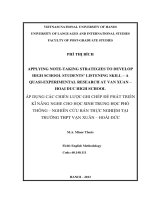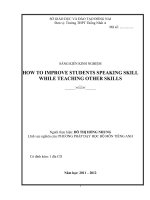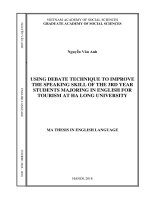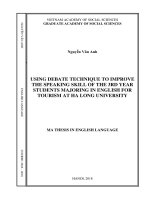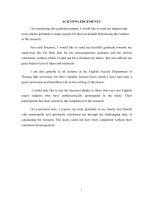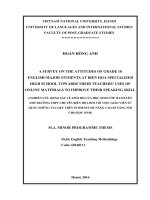The implementation of debate technique to improve students’ speaking skill ( a classroom action research at grade nine of oxford center)
Bạn đang xem bản rút gọn của tài liệu. Xem và tải ngay bản đầy đủ của tài liệu tại đây (929.31 KB, 67 trang )
VIETNAM NATIONAL UNIVERSITY, HANOI
UNIVERSITY OF LANGUAGE AND INTERNATIONAL STUDIES
FACULTY OF POST GRADUATE DEPARTMENT
TRẦN THỊ HẢO
THE IMPLEMENTATION OF DEBATE TECHNIQUE TO IMPROVE
STUDENTS’ SPEAKING SKILL (A CLASSROOM ACTION
RESEARCH AT GRADE NINE OF OXFORD CENTER)
Nghiên cứu về việc áp dụng các thủ thuật tranh luận để thúc đẩy khả
năng nói của học sinh (Một nghiên cứu hành động ở học sinh khối 9 tại
trung tâm Oxford)
M.A. MINOR PROGRAMME THESIS
Field: English Teaching Methodology
Code: 60140111
HANOI - 2015
VIETNAM NATIONAL UNIVERSITY, HANOI
UNIVERSITY OF LANGUAGE AND INTERNATIONAL STUDIES
FACULTY OF POST GRADUATE DEPARTMENT
TRẦN THỊ HẢO
THE IMPLEMENTATION OF DEBATE TECHNIQUE TO IMPROVE
STUDENTS’ SPEAKING SKILL (A CLASSROOM ACTION
RESEARCH AT GRADE NINE OF OXFORD CENTER)
Nghiên cứu về việc áp dụng các thủ thuật tranh luận để thúc đẩy khả
năng nói của học sinh (Một nghiên cứu hành động ở học sinh khối 9 tại
trung tâm Oxford)
M.A. MINOR PROGRAMME THESIS
Field: English Teaching Methodology
Code: 60140111
Supervisor: Mai Thị Loan. PhD
HANOI - 2015
CANDIDATE’S STATEMENT
I certify my authorship of the thesis submitted today entitled: “The
implementation of debate technique to improve students’ speaking skill (A
classroom action research at grade nine of Oxford center)” is the result of my own
work for the Degree of Master of Arts at University of Languages and International
Studies, Hanoi National University. The material in this thesis has not been
submitted for assessment in any other courses of study.
Hanoi, November 2015
Signature
Trần Thị Hảo
i
ACKNOWLEDGEMENTS
I am, first of all, greatly indebted to my thesis supervisor, Ms. Mai Thi Loan,
for encouraging me to complete this work. Without her valuable instructions,
comments, criticisms and corrections, this research would have been made
impossible.
My appreciation and gratitude are also extended to all my colleagues,
students at Oxford Center who have stimulated and guided my thinking during the
time I did this research.
Last but not least, I owe a big debt to my loved family who always stand by
me as well as give me strength and encouragement during my course and during the
time I fulfilled the research.
ii
ABSTRACT
There is no doubt that speaking skill is one of the essential skills in teaching
and learning English. Nowadays, a lot of students have difficulty in learning
speaking skill.
From this fact, the thesis was conducted to evaluate whether the
activity called “debate technique” could help the student improve their speaking
level. The material that the researcher chose was “Solutions – Intermediate
Student’s book”. This book is in current use for the grade nine at Oxford center.
The data collection instruments employed in this study were tests (pre-test
and post-test), questionnaire for students and questionnaire for teachers. These tests
helped researcher to find out how far the implementation could help students
improve their speaking skill. In addition, the questionnaires helped the author find
out the effective ways that debate technique should be conducted.
Research findings have indicated that after applying debate technique, the
students’ speaking score increased significantly. Based on the findings, the
suggestions would be given for better application of the use of debate technique in
speaking lessons.
iii
LIST OF ABBREVIATIONS
1. No:
Number
2. Q:
Question
3. %:
Percentage
4. Std.
Standard deviation
5. L2:
Second language
iv
LIST OF CHARTS AND TABLES
Chart 1: Raw marks in speaking test (pre-test) .........................................................22
Chart 2: Raw marks in speaking test (post-test) .......................................................24
Chart 3: Students’ attitude towards debate technique ...............................................26
Chart 4: Students’ improvement after they had been taught with the implementation
of debate technique. ...................................................................................27
Chart 5: Steps students follow during speaking lessons ...........................................28
Chart 6: Students’ favorite debate style in speaking lessons ....................................29
Chart 7: Teachers’ frequency of implementing debate technique to teach speaking skill32
Chart 8: Students’ improvement after they had been taught with the use of debate
technique ....................................................................................................33
Chart 9: Teachers’ choice about debate style in speaking lessons ............................34
Chart 10: The steps that teachers conduct a debate activity .....................................34
Table 1: Frequency distribution (pre-test) ................................................................22
Table 2: Mean and Std. Deviation (pre-test) .............................................................23
Table 3: Frequency distribution (post-test) ...............................................................24
Table 4: Mean and Std. Deviation (post-test) ...........................................................25
Table 5: The effectiveness of debate technique in speaking lessons ........................30
v
TABLE OF CONTENT
Candidate’s statement .................................................................................................. i
Acknowledgements .....................................................................................................ii
Abstract ..................................................................................................................... iii
List of abbreviations ................................................................................................... iv
List of charts and tables............................................................................................... v
Table of content .......................................................................................................... vi
PART I: INTRODUCTION ..................................................................................... 1
1. Rationale of the study.............................................................................................. 1
2. Aims and objectives of the study ............................................................................ 2
3. Research questions .................................................................................................. 2
4. Scope of the study ................................................................................................... 2
5. Significance of the study ......................................................................................... 2
6. Methods of the study ............................................................................................... 2
7. Design of the study.................................................................................................. 3
PART II: DEVELOPMENT .................................................................................... 4
CHAPTER I: LITERATURE REVIEW ................................................................ 4
1.1 Concept of speaking .............................................................................................. 4
1.1.1 Definition of speaking ........................................................................................ 4
1.1.2 Characteristics of a speaking lesson ................................................................... 5
1.2 Concept of debate .................................................................................................. 7
1.2.1 Definition of debate............................................................................................ 7
1.2.2 Advantages and disadvantages of using debate technique in speaking ............. 8
1.3. Previous study ...................................................................................................... 9
CHAPTER II: METHODOLOGY........................................................................ 11
2.1 Research method ................................................................................................. 11
2.1.1 Overview of action research............................................................................. 11
2.1.2 Rationale for the use of an action research ...................................................... 12
2.2. Description of the context of the research ......................................................... 12
2.2.1 The current situation of teaching and learning English at Oxford center. .............. 12
2.2.2 The teaching program and material ................................................................. 13
vi
2.3. Description of the research................................................................................. 14
2.3.1 Participants ....................................................................................................... 14
2.3.2 Data collection instruments .............................................................................. 14
2.3.2.1 Tests .............................................................................................................. 14
2.3.2.2 Questionnaires ............................................................................................... 14
2.4 Data collection procedures .................................................................................. 15
2.5 Data analysis method .......................................................................................... 16
2.6 The use of debate technique in the speaking lessons .......................................... 17
CHAPTER 3: DATA ANALYSIS AND DISCUSSION ...................................... 19
3.1 Tests .................................................................................................................... 19
3.1.1 Aim ................................................................................................................... 19
3.1.2 Participants ....................................................................................................... 19
3.1.3 Test description ................................................................................................ 19
3.1.4 Data analysis and finding ................................................................................. 22
3.1.4.1 Pre-test........................................................................................................... 22
3.1.4.1.1 Frequency distribution ............................................................................... 22
3.1.4.1.2 Correlation.................................................................................................. 23
3.1.4.2 Post-test ......................................................................................................... 24
3.1.4.2.1 Frequency distribution ............................................................................... 24
3.1.4.2.2 Correlation.................................................................................................. 25
3.2 Questionnaire for students................................................................................... 26
3.2.1 Aims ................................................................................................................. 26
3.2.2 Participants ....................................................................................................... 26
3.2.3 Data analysis .................................................................................................... 26
3.2.3.1 Students’ attitude towards debate technique ................................................. 26
3.2.3.2 The improvement of students’ speaking skill after they had been taught
through implementation of debate technique ............................................................ 27
3.2.3.3 Steps students follow during speaking lessons ............................................. 28
3.2.3.4 Students’ favorite debate style in speaking lessons ...................................... 29
3.2.3.5 The effectiveness of implementation of debate technique in speaking lessons ... 30
3.2.3.6 Some disadvantages of implementation of debate technique in speaking
vii
lessons. ...................................................................................................................... 31
3.3 Questionnaire for teachers................................................................................... 32
3.3.1 Aims ................................................................................................................. 32
3.3.2 Participants ....................................................................................................... 32
3.3.3 Data analysis .................................................................................................... 32
3.3.3.1 Teachers’ frequency of implementing debate technique to teach speaking skill .... 32
3.3.3.2 The improvement of students’ speaking skill after they had been taught with
the use of debate technique ....................................................................................... 33
3.3.3.3 Teachers’ choice about debate style in speaking lessons .............................. 34
3.3.3.4 The steps that teachers conduct a debate activity ......................................... 34
3.3.3.5 Difficulties when designing a speaking lesson with implementation of
debate technique ........................................................................................................ 35
PART III: RECOMMENDATIONS AND CONCLUSIONS ............................. 36
1. Recapitulation ....................................................................................................... 36
2. Implications ........................................................................................................... 36
3. Limitations of the research .................................................................................... 38
4. Suggestions for further studies .............................................................................. 38
References ................................................................................................................. 39
Appendix 1 .................................................................................................................. I
Speaking test (pre-test) ................................................................................................ I
Appendix 2 ................................................................................................................. V
Speaking test (post-test) ............................................................................................. II
Appendix 3A: Survey questionnaire for students .................................................... III
Appendix 3B: Nghiên cứu về việc áp dụng thủ thuật tranh luận để thúc đẩy kĩ năng
nói của học sinh .......................................................................................................... V
Appendix 4: Survey questionnaire for teachers ...................................................... VII
Appendix 5: A sample lesson plan ......................................................................... VIII
Appendix 6: The formula of mean, standard deviation and median .......................... X
viii
PART I: INTRODUCTION
1. Rationale of the study
English is considered a compulsory subject in almost schools in Vietnam from
primary schools to universities and has gained its significance among various
foreign languages in the world. One of the main goals when teaching a foreign
language (FL) now is to promote students’ communicative competence especially in
the context of industrialization and modernization.
The communicative competence is carried in both oral and written form;
however, in many aspects of life, “speaking is the process of building and sharing
meaning through the use of verbal and non-verbal symbol in a variety of context”
(Chancy, 1998:13). A good oral communicative competence may be paid more
attention to than written ability. It is obvious that being able to speak English brings
more opportunities for students in their study as well as in the future career
prospect. At Oxford Center, the students are taught four skills: reading, writing,
listening and speaking skill. The problem is that, due to the demand of
examinations, students’ focus is on grammar and when being transferred to the high
school, students may lack speaking skill which is one of the most important areas in
learning English. Students also may have some difficulties in communicating using
English such as fears of public speaking or being passive in speaking lessons and so
on. It is really important for the teacher to find out the effective techniques to help
students improve speaking skill
There are several techniques to be used to teach speaking skills. One of the
techniques in teaching speaking skill is debate technique. It is seen as an active
learning process because students will learn more through a process of constructing
and creating, working in a group and also sharing knowledge.
Based on the explanation above, the researcher decides to conduct a research
on “The implementation of debate technique to improve students’ speaking skill.”
1
2. Aims and objectives of the study
The study aims at applying debate technique to improve the students’ speaking
skill. To be more specific, the objectives of this study are to:
- To measure the improvement of students’ speaking skill after the
implementation of debate technique.
- To find out the effective ways of using debate technique to teach speaking
skill for Oxford Center’s students.
3. Research questions
In order to reach the above aims and objectives, the study is going to seek
answers for the following research questions:
How far does the use of debate technique improve the students’ speaking skill
at the grade nine of Oxford Center?
How should the debate technique be implemented to improve the students’
speaking skill?
4. Scope of the study
The theory of English teaching speaking is complex comprising a number of
components. However, the research focuses on the implementation debate technique
to improve the students’ speaking. It was conducted among nine-grade students at
Oxford Center.
5. Significance of the study
In terms of theory, the author expected to contribute the effective ways to
teach English speaking skill. The study is hoped to raise teachers’ awareness of the
implementation of debate technique to improve students’ speaking skill. In terms of
practice, the findings of this study can be used as a reference for teachers of English
in general and teachers at Oxford Center in particular to improve their teaching.
6. Methods of the study
The data serving the research analysis and discussion will be collected by means of:
- Pre-test and post-test for both experimental and control groups;
- A survey questionnaire for experimental group;
- A survey questionnaire for teachers of English at Oxford Center.
2
7. Design of the study
The study will be divided into three parts:
Part 1: Introduction shows rationale, aims, objectives, research questions,
scope, significance, methods and design of the study.
Part 2: Development includes three chapters:
Chapter 1: Literature review deals with some theoretical background of
teaching and learning speaking, knowledge of debate and previous studies
Chapter 2: Research methodology focuses on the research method-action
research, action research procedure for this study, the current situation of teaching
and learning at Oxford Center, participants of the study, data collection instruments
and data collection and analysis procedure.
Chapter 3: Data analysis
This chapter provides an analysis of the collected data in the action stage: tests
( pre-test and post-test), questionnaires for students and questionnaire for teachers.
Part 3: Recommendations and conclusion summaries the results of the
study. Recommendations and limitations of the study are also pointed out. Finally,
some suggestions for further studies are presented.
3
PART II: DEVELOPMENT
CHAPTER I: LITERATURE REVIEW
1.1 Concept of speaking
1.1.1 Definition of speaking
Some people may think that speaking competence is the product of language
learning; however, speaking becomes an essential factor of the language learning
process besides listening, reading and writing. According to Florez (1999:98),
speaking is an interactive process which students produce and receive information
to create the meaning. Bailey (2003:7) also defined speaking is the productive
aural/oral skill which contains the systematic verbal utterances production in order
to convey the meaning. It can be understood in a simple way that speaking is the
capable of speech using language to express or exchange thoughts among people
(Mart, 2012:12).
Speaking is not a simple skill; it requires the experience and practice with the
other language skills. According to Thornbury (2005:78), second language speaking
is different from first language speaking due to the lack of vocabulary and grammar
knowledge of learners; the process of arranging grammar and words which is not
automatic in producing second language. Speaking is defined as a complex process
of exchanging thoughts not only by using verbal expressions but also non-verbal
symbols such as gestures, body language and facial expressions. From the
communicative point of view, Harmer (2001:23) stated that speaking has various
aspects including two major categories, namely accuracy and fluency. Accuracy is
the correspondence between students’ speech and what they actually say when
using the target language (Bailey, 2003); and the correct use of vocabulary,
grammar, pronunciation practiced through guided activities (Harmer, 2001).
Fluency is the ability to maintain speaking confidently with few hesitations or
unnatural pause, false starts, word searches and so on (Bailey, 2003).
4
In short, speaking competence happens when the speakers have ability to
communicate by exchanging the information accurately and fluently with suitable
selection and use of vocabulary and structures. Generally, speaking is the ability to
express something in spoken language by arranging ideas into words so that people
understand the message conveyed (Al-Tamimi & Attamimi, 2014). In this study, the
term speaking is one of the four skills related to language learning and teaching.
1.1.2. Characteristics of a speaking lesson
Florez (1999:108) provided a general outline of a speaking lesson following
five patterns of preparation, presentation, practice, evaluation, and extension. In the
first step of preparation, teachers have to create a speaking context and emphasize
the awareness of speaking skills which is focused; for example, asking for
clarification, stressing key words or word form reduction. In presentation step,
teachers can model a speech which will be the target for the lesson and make
learners become more attentive when observing the use of language produced by
the teachers. Practice stage requires all students to participate in controlled and
guided activities using the target structures. Students may be asked to monitor and
assess their own work in terms of skills being examined in evaluation step. And
finally, extension involves activities requiring students to combine the new skill or
strategy with what they have acquired, or using the target skills in a different
context or real communicative situation.
As mentioned above, speaking is not only one of four important skills in
language learning process but also becomes an advantage for learners in social life
when applying for a job, for instance. To master a second language, students should
become a good speaker who meets the demand of two criteria- accuracy and
fluency; thus, they should be taught speaking activities which are organized
appropriately to help them achieve the aim. Therefore, characteristics of a speaking
lesson have been studied so that teachers can follow and limit the shortcomings
affecting students’ speaking competence. According to Ur (2000:87), five features
of a good speaking lesson are following:
5
Students talk a lot
Study showed that teacher-dominated classroom talk is considered one type of
unequal power discourse (Bailey, 2003:67). However, classroom activities must be
designed in such ways that most of the time assigned is captured by learners with
not too much teachers’ talk or pause. Teacher talks too much, which becomes the
argumentative issue among teachers when teaching the second language. They also
suggested finding the root of the problem and starting from there; for example, due
to the different cultures or the lack of motivation to speak in class. One further
interesting point given by Bailey (2003:68) is that students can play different roles
of a teacher when the teacher is eliminated from the conversation. Thus, teachers
should give students their own power in some situations such as deciding the topics,
asking questions or even giving feedback.
All students get equal opportunity to speak
Some teachers may have a bad habit of calling talkative students to make a
speech while ignoring the other passive ones. Students who have fears of public
speaking may depend on the dominant students in class, especially in group work
activities; so they have fewer chances to talk However, a good speaking lesson
means that participation is even, which the minority of active students should not
dominate classroom discussion and contributions must be reasonably distributed.
Students are highly motivated
The role of motivation is mentioned in the definition section that it becomes an
essential factor in course design. Macnamara (1971:112) confirmed that “the
essential difference between a classroom and the street as a place to learn a
language is motivation” (Rubin, 1975:43). A speaking class should be the place
where students are motivated to talk as much as possible. After finishing a lesson,
students have willingness to communicate, which makes the lesson become
successful. Hence, motivation turns to a characteristic of a speaking lesson and has
an intimate relation with speaking activities.
6
Language used is comprehensible
Speaking is not only transferring messages to other people but also is
communication. To make it as communication, language should be used explicitly
together with fluency and accuracy so that the information can be conveyed
effectively. Bailey (2003:98) pointed out that learners at the beginning and
intermediate levels must be given opportunities to improve their fluency and
accuracy.
Students talk in the target language
Cole (1998:145) showed that there are very few reasons for using mother
tongue during language speaking activities. It is suggested that first language should
not be used when teachers give the instructions of the exercises or games which are
not too complicated. In addition, teachers should not use the first language in
pronunciation except for explaining abstract words. The ability to define words and
describe things using target language is considered a useful tool that language
learners should master. Therefore, teachers need to try hard and encourage students
to speak in foreign language during speaking lessons.
From my point of view, one speaking lesson should have five patterns of
preparation, presentation, practice, evaluation and extension. These steps should be
included in a speaking lesson so that the teachers can follow and limit the
shortcomings affecting students’ competence.
1.2 Concept of debate
1.2.1 Definition of debate
A debate has been described as a form of argument that “has strict rules of
conduct and quite sophisticated arguing techniques” (ACT Debating Union Inc.
1996). It must have a topic that has scope of argument, i.e. there must be at least
two sides of the topic.
According to Mabrur (2002:5), debate is technique which involves two or
more speakers, discussing certain topics; giving their opinions, thoughts and facts;
then giving respond to relevant questions of comments from others in the class.
7
Havorsen (2005:8) said that debate forces students to think about the multiple sides
of an issue and it also forces them to interact not just the details of a given topic, but
also with one another. Debate can be implemented as the alternative way to teach
speaking. Debate is different from other techniques. In debate, the students are
given some topics to be discussed. One or among students of them present their
opinions and facts concerning the topics. The next step, he gives responses to the
questions and comments from his friends in the class.
In my opinion, debate or debating is a formal method of interactive and
representational argument. This technique involves at least two speakers who
discuss about certain topics and give their ideas about certain ones.
1.2.2 Advantages and disadvantages of using debate technique in speaking
There are a lot of researches discussing about the advantages and disadvantages
of using debate technique in speaking lessons. It cannot be denied that debate brings
certain benefits for students and teachers. Debating is a teaching strategy that
provides a framework for students to explore and develop a range of views over an
issue. According to Halvorsen (2005: 98) debate encourages students to:
Improve the quality of their responses as they are provided with thinking time
and they can build upon their own ideas
Stay on task as they have to present their ideas and listen to their peer
Present their views to an authentic audience
Develop co-operative learning skills
Develop research skills
Formulate an argument
Explore a variety of views
Krieger (2005:76) acknowledged the usefulness of debate in language learning
because it “engages students in variety of cognitive and linguistic ways”. Teachers
often use the debate to effectively increase students’ involvement and participation
during sessions.
8
However, debate technique also has some disadvantages in speaking lessons.
According to Halvorsen (2005: 98), the weaknesses of debate implementation are:
Debate is only used for certain subjects especially in speaking subject
The implementation of debate needs long time
Debate can make the students emotional in defending their argument. Sometimes,
they are very emotional in expressing their argument; moreover, if they must defend
their stand or opinion which is in contradiction with theirs
Teachers get difficulties in controlling the debate complementation
It is my belief that debate technique has several significant advantages. It can
help the students develop their co-operative skills, research skills and build their
own ideas. However, debate technique also has some shortcomings such as
difficulty to apply in certain topics, long time to implement, etc. In summary, the
teachers need to make use of the advantages and limit the disadvantages of debate.
1.3. Previous study
There have been a lot of studies working on various activities to improve
learners’ speaking skill in the world and in Viet Nam. However, there are not many
of them on debate technique as well as the effects of using debate technique in
speaking lessons.
There are a lot of famous studies about debate technique in the world. One of
the first authors is Krieger (2005), who acknowledges the usefulness of debate in
language learning because it “engages students in variety of cognitive and linguistic
ways”. Teachers often use debate to effectively increase students’ involvement and
participation during sessions. Also, Chen and Wang (2013) who advocated debate
activities showed many significant advantages in speaking class, for example,
giving students more opportunities to speak in class, developing students’
confidence and motivation by creating a positive classroom atmosphere, as well as
establishing the social relationship with other people and improving problem
solving skills. Thus, debate activities help students a lot in learning speaking skill,
which is one of the prior skills in modern language.
9
In the context of Viet Nam, there are also many studies about improving
speaking skill in the classroom. However, there are not many studies about
implementation of debate technique in speaking lesson. Tran Thi Mai (2008) carried
out a research on implementing task-based teaching to improve students’ speaking
skill for 10 graders at Ngo Quyen upper secondary school. An action research was
planned and implemented with such data collection instruments as questionnaire,
classroom observation, and document analysis. The results showed that to improve
students’ involvement in speaking lessons, teachers should modify the activities
from textbook to make them suitable for their students. Moreover, organizing
debate groups in large classes is considered an important factor to help modify prespeaking activities more successful.
Hoàng Đức Đoàn (2009) conducted a study on motivation in learning English
speaking of the second-year tourism major students at Tourism and Foreign
language department in Sao Do College of industry. In the study, she presented the
potential values of using group work, role-play and debate activities. From the
results, it can be concluded that language teachers should apply more debate
technique to their speaking lessons.
Bùi Thị Ánh Tuyết (2009) conducted a study on using classroom activities to
stimulate students’ presentation in English speaking lessons at Marie Curie School
in Hai Phong. The research found out that it was necessary and beneficial for
teachers to use debate technique in teaching speaking skill. In addition, students
also felt motivated and interested in their teachers’ use of debate technique in class.
Given the teaching and learning situation, the researcher is aware of
importance of debate activities mentioned in the previous studies. The fact is that
there has been little research into implementing debate technique to improve
students’ speaking skill. Therefore, the researcher decided to make an action
research to explore the effects of debate technique on improving the grade – nine
students at Oxford Center.
10
CHAPTER II: METHODOLOGY
2.1 Research method
2.1.1 Overview of action research
The term action research can be understood as the combination between
implementing a plan and developing the understanding of the effectiveness of this
implementation. Action research can revitalize the whole learning community, as
well as help teachers in changing or reflecting on their classroom practices
(Calhoun, 1993:12). After that, Cunningham (1993:98) defined action research as a
term for describing a spectrum of activities that focus on research, planning,
theorizing, learning and development. “It describes a continuous process of research
and learning in the researcher’s long-term relationship with a problem”.
The aim of action research defined by Todd (2010:2) is to “develop the
teaching situation and the teacher-researcher rather than generate new knowledge”.
The research does not face the problems of reliability and generalization because
action research “generates findings which are useful within a specific context rather
than findings applicable across many different situations” (Todd, 2010:5). With
such merits, action research was selected for this study, which is small-scale and
practical in nature.
Also, McTaggart (1994:5) believed that action research is a form of selfreflective investigation conducted by participants to solve the problems in society,
which consists of four steps planning, action, observation, and reflection:
a. Planning: a problem is identified and a plan of action is developed
b. Action: the plan is put into action
c. Observation: the effects of the action are observed
d. Reflection: the effects of the action are evaluated and become the basis for
further planning.
In short, the aim of action research is to identify problematic situations or
issues that participants consider worth investigating and to undertake practical
11
interventions in order to bring informed changes in practice. Action research is
chosen as the research method in this study as it is suitable for the real situation and
helps to develop the participants’ understanding in order to improve educational
practices.
2.1.2. Rationale for the use of an action research
Mills (2003: 4) defined that action research is “any systematic inquiry
conducted by teacher researchers to gather information about the ways that their
particular school operates, how they teach, and how well their students learn.” The
information is gathered with the goals of gaining insight, developing reflective
practice, effecting positive changes in the school environment and on educational
practices in general, and improving student outcomes.
Whenever English teachers find out a problem, they need to make a further
look into the problem and give a suitable solution. Therefore, they often carry out
action research for most of the time.
2.2. Description of the context of the research
2.2.1. The current situation of teaching and learning English at Oxford center.
Oxford center was founded in 2005. It is situated in Van Quan urban town, Ha
Dong, Ha Noi. Nowadays, it has four branches with modern equipment. Each
branch is a big building with 6 floors. Each branch consists of about 10 classrooms
with 35 chairs and tables in each class. The tables and chairs are designed to be
small and beautiful, which is suitable with students. In the class, there are 1 TV or 1
projector, 1 board, 35 tables and chairs with many beautiful pictures on the wall.
This center has more than 100 classes with various levels.
Teachers in this center include both Vietnamese and native teachers.
Vietnamese teachers are people who already have experience and graduated from
university with the major of English education. In addition, native teachers are
people who have certificate in teaching and come from England or America.
Besides, Oxford center has many staffs that master English and are willing to
answer any questions from students’ parents.
12
First of all, the current common English teaching method is teachers’
explanation for students. In general, the students are quite passive in learning; they
just listen and get knowledge in four skills: listening, speaking, reading and writing,
especially in speaking skill. As a result, this teaching method does not encourage
students to practice speaking because the teachers act most of time in the class.
Secondly, almost all students at Oxford center wish to improve their speaking
skill. They want to learn this skill in such a creative and active way like: working in
pairs, working in groups, debating activities. This reason makes teacher think about
the suitable methods for their students.
The final problem is the students’ different level in speaking English. Some of
them are good, but some of them are not really good at English even though they
have chances to learn with foreign teacher two hours a week.
Having found those problems, I would like to do the research called: “The
implementation of debate technique to improve students’ speaking skill.
2.2.2. The teaching program and material
The course book called “Solutions – Intermediate Student’s book” written by
Tim Paul A Davies, 2006, Oxford University Press
The Student’s Book contains;
- Ten topic- based units, each covers seven lessons
- Five Language Review/ Skill Round – up sections, providing a language test
of the previous two units and a cumulative skill-based review
- Five Get Ready for your Exam sections providing typical exam tasks and
preparation
- Ten Vocabulary Builders with practice and extension
- Ten Grammar Builder Reference sections containing grammar reference and
further exercises.
As for the syllabus, each unit is taught in two weeks, each period lasts fifty
minutes. The course lasts 24 weeks of studying. The main aim of the course focuses
on students’ speaking skills.
13
2.3. Description of the research
2.3.1. Participants
Students targeted in this study belong to the grade – nine students of Oxford
Center. In this study, 70 students are chosen from two classes to take tests: pre-test
and post-test. After that, 35 students in class A and 15 teachers are chosen to answer
for questionnaire. The majority of students will be within the 14 – 15 age range. The
research was conducted at Oxford Center in Hanoi. The reason for choosing is that
the students at that level are almost not good at speaking English. They are afraid of
talking in English, lack vocabulary and confidence. This study is expected to help
them to improve their speaking skills by applying debate technique.
2.3.2. Data collection instruments
Both questionnaires and tests were employed in this research so as to get the
accurate data. These instruments help the researcher get more in-depth data for
analysis.
2.3.2.1 Tests
The aims of tests were to answer the first research question that how far debate
technique can help students make progress in their speaking skill. The time
allowance for each student in the test is 6-8 minutes. The test consists of pre-test
and post test with the equivalent difficulty level. The pre-test was carried out at the
first week of the course. The post-test was carried out at week 12 in the course.
2.3.2.2 Questionnaires
The questionnaire is one of the most popular instruments in gathering data in
each research. It is easy to prepare and can be given to large groups of subjects at
the same time. It also helps the researcher get a large amount of information with a
short period of time. In this research, the researcher exploited two kinds of
questionnaire: one for students and one for teachers.
Questionnaire for students
The questionnaire for students aims at finding out their opinions and attitudes
towards the implementation of debate technique in speaking lessons. It was
14
delivered to students in class A after being taught with debate technique. It consists
of six questions which focus on six main aspects that the researcher would like to
investigate as follows: question 1 aimed at finding the students’ attitude towards
debate technique in general; question 2 worked out the degrees in which debate
technique could help the students improve their speaking skill; question 3 found out
steps that the students follow during debate time; question 4 clarified what debate
style that the students would like to join in speaking lessons; question 5 clarified
students’ benefits when they use debate technique; question 6 worked out the
drawback of using debate technique.
When delivering the questionnaire, the author translated it from English to
Viet Namese to make sure students understood the question completely. Especially,
students were allowed to write in Vietnamese about the drawbacks of using debate
technique so that they could express their feeling directly.
Questionnaire for teachers
The questionnaire for teachers consists of five questions which aim at finding
out the ways and what kind of debate styles the teachers used to teach speaking:
question 1 aimed at finding out the frequency the teachers use debate technique in
speaking lessons; question 2 worked out the degrees in which debate technique can
help students improve their speaking skill; question 3 found out debate style which
the teachers choose to teach; question 4 aimed at finding out how the debate
technique should be conducted in speaking lessons; and question 5 clarified
difficulties the teachers encountered while designing the lessons.
2.4 Data collection procedures
The researcher carried out this study during the process of teaching. There
were 35 students in each class. Debate technique is a method that the author applied
to just class A. Class B was taught without using debate technique.
The use of instruments in the data collection was primarily illustrated in the
following timeline.
15
